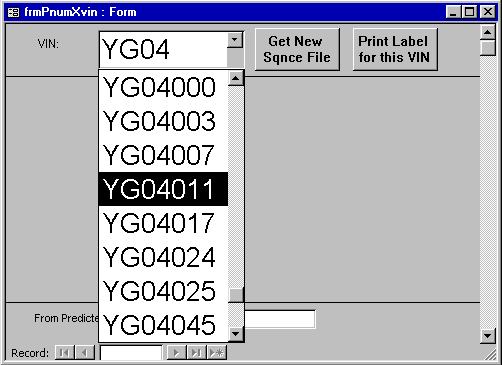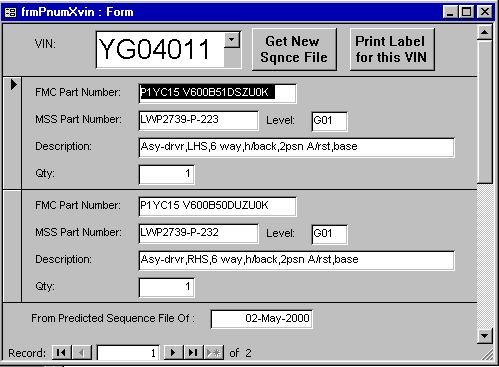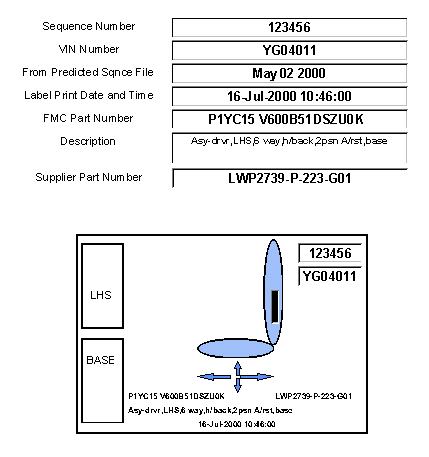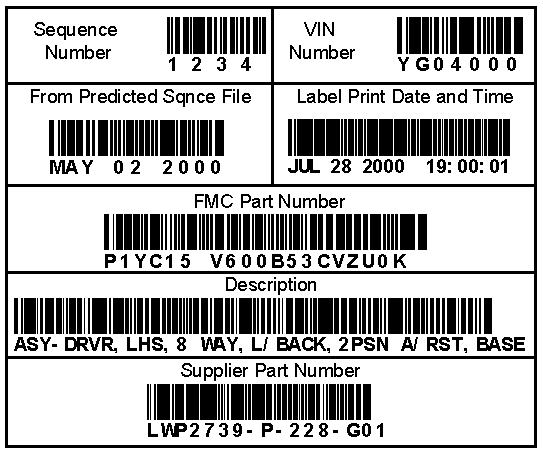- Download and run the MSAccess97 predicted sequence file reader.
-
To run on MSAccess2000 create a new database file and import all the tables, queries,
forms, reports, macros and modules from the downloaded file.
Open a module and use tools and preferences to enable a reference to MS DAO
- suggest use the highest numbered version: 3.6
Testing on some installations of MSAccess97 has identified errors arising through active X controls used for bar coding not being registered on local machines.
In the event of run time errors try opening a module and using tools and references then revoke the reference to the 2 activeX bar code controls. - Running on MSAccess97 will self open form frmPnumXvin, if converted to MSAccess2000 then open this form.
-
The file as downloaded already contains a translated DELJIT file.
To find out what parts are in what VIN click on the downward arrow on the VIN box to see
what VINS are in the predicted sequence file last read by the reader.
You can type in a vin from scratch or part type a vin and select matches from the list.

-
After typing a VIN and pressing enter or by selecting a VIN from the list the parts called up in the
DELJIT message are listed.

-
Once part numbers are listed against a VIN you generate labels.
The pick box allows selection of label style. Choice is: - rptSimple is a simple text label
- rptActiveBarCode includes bar codes but requires installation of ActiveX control downloadable from www.activebarcode.com This is shareware with a 30 day free trial period.
- rptBarCodeIntermec uses barcodes suitable for intermec label printers and requires installation of activeX controls and printer drivers from the intermec website.
- rptGraphic uses logical descriptions referenced in a lookup table to display specific graphical content on the label. The content is specific to seats but is easily adpatable for any other commodity.
-
Clicking on the print label button prompts for whether or not print or preview is required, then prompts for sequence number.
There is no point extracting the sequence number from the DELJIT message as it will be different by the
time the VIN is broadcast.
Clicking OK without typing a sequence just means the sequence will be blank on the label.
Examples of a graphic label and a bar coded label below:


- Enquiries for bespoking would be considered.
-
To load in a new predicted sequence file you obviously need to have received a file from FMC.
For trial purposes try downloading a file from the page previous to this and clicking on the get new
file box.
This prompts for the file name - it is fine to rename the file as received.
It can take a couple of minutes to read a file containing five days of VINs. Completion
is marked by the automatic closing of the progress bar window.

- The data is loaded into a table called tblSource and the file date is saved in table tblFileDate. The table tblSPmdlGenkEndItems is the lookup table for supplier part numbers and descriptions, it is partly resistant to FMC part number format differences and matches without reference to the suffix level.
- This reader is tolerant of the truncated spaces experienced in email DELJIT files
- There are several useful queries in the database file too. Some test for obvious predicted sequence integrity issues but are probably largely specific to seats. Tests include checking for 2 and only 2 front seats per VIN for example. Feel free to browse these.
- OK - that's it. Good luck and happy sequencing.
|
Contact Simon Prior : |
